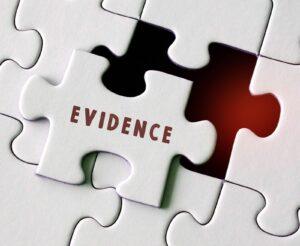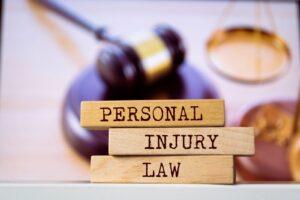
Evidence in Personal Injury Claims
Many people are under the mistaken belief that because someone acted in a way that interfered with their activity or inconvenienced them in some way, they are entitled to file a civil lawsuit against that person. Perhaps you have even witnessed an accident after which one of the parties—usually the angry one—threatens to sue the other party because:
- “Now, I am going to be late for work!”
- “You made me look like a fool!”
- “You frightened my child!”
- “I don’t have time for this!”
In most cases in which these are the complaints, no one files a lawsuit and cooler heads prevail.
However, there are other accidents after which one of the parties may exclaim something like:
- “Help me! I can’t get out!”
- “Call an ambulance!”
- “Look what you did to my car!”
- “I can’t move my _______ (fill in a body part)!”
These are exclamations of more than just inconvenience. When a party complains of these types of injuries, this is most likely an accident in which something is damaged, someone is injured, and someone has a right to file a personal injury claim against the other party. But what type of evidence is needed to support such a claim?

What Must the Evidence Prove in a Personal Injury Case?
Before you can know what evidence is needed to support a personal injury claim, you must understand the elements of the claim that must be proven. In most personal injury claims based on negligence, the person filing the complaint (the “plaintiff” or “petitioner”) must prove the following four elements:
- Duty. For a defendant to be negligent, they had to have owed a duty of care toward the plaintiff. Whether a defendant owed a duty to the plaintiff may depend on whether a reasonable person would conclude that, under the circumstances that existed at the time, the defendant should have been more careful toward the plaintiff when they took whatever action they took that caused the accident.
For example, when a defendant drives a car through a busy intersection in a major city at lunch time, the intersection has a traffic light indicating red (stop), and there are traffic signs at the corner of the intersection that read: “Use Caution. Wait for Pedestrians to Cross,” the defendant most likely owes a duty of care to the pedestrians crossing the street. However, if the defendant was driving their car down a long, private driveway leading from their secluded home to the nearest access road when they suddenly struck a trespasser who they did not expect to be on their private property, the defendant probably owed no duty of care toward the trespasser.
- Breach. In addition to the defendant owing a duty of care to the plaintiff, the plaintiff must show that the defendant breached their duty by not exercising reasonable care with respect to their duty. Thus, in the pedestrian-crossing example above, the plaintiff must show that the defendant acted unreasonably with respect to the care they showed to pedestrians when proceeding through the intersection.
- Proximate causation. Assuming the plaintiff can show that the defendant breached a duty of care owed to the plaintiff, they must also show that the defendant’s actions actually caused the injuries that the plaintiff sustained. This is often referred to as “but for” causation, which means that, were it not for the defendant acting the way they did, the plaintiff would not have been injured. Thus, the plaintiff must show a proximate relationship between the defendant’s actions and the plaintiff’s injuries.
In our pedestrian-crossing example, if the pedestrian/plaintiff’s injuries were the result of the defendant proceeding through the intersection while looking at their car radio when striking the plaintiff with the car, then the plaintiff could most likely show that any injuries sustained were the result of the defendant striking her with the car. However, if, when the defendant struck the plaintiff, the plaintiff jumped to her feet and ran across the intersection in embarrassment, only to trip over a briefcase that a businessman left on the curb, causing the plaintiff to fall to the ground and injure herself, the plaintiff may have some difficulty showing that, were it not for the defendant carelessly pulling through the intersection and striking her with the car, she would not have been injured.
- Injury (actual damages). Even though a defendant may have breached a duty owed to the plaintiff and the defendant’s action in breaching that duty was proximately related to the plaintiff, the defendant will not be found to have been negligent unless the plaintiff can show that they were injured. Actual injury must consist of actual damages, such as to property or some physical injury to the person. If the plaintiff suffered no damage to themselves or any property, then there is nothing for which the defendant should compensate the plaintiff financially.
For our pedestrian, if she can show that when the defendant struck her with the car, she suffered a broken wrist that required hospitalization, surgery, and rehabilitation, all of which she had to pay for, then she could show actual damages for which the plaintiff should compensate her. However, if she was not injured physically in any way and required no medical care but, instead, simply felt embarrassed, then she could not support a personal injury claim because she incurred no damages for which she required financial compensation.
Contact our Kansas city personal injury lawyers now.

What Evidence Is Needed to Be Compensated for My Injuries?
Assuming a plaintiff can satisfy all the elements of negligence for a personal injury claim, the question then becomes: “What evidence must the plaintiff show to be compensated? What damages can be awarded?”
In Missouri, a plaintiff in a personal injury suit may be compensated for:
- Property damage
- Medical expenses
- Pain and suffering
- Lost income and future wages
- Emotional distress
- Loss of consortium (brought by family members in wrongful death claims)
- Punitive damages
The evidence that will be most relevant in proving these damages are:
- Medical records
- Medical bills (for treatment & follow up care
- Employment records
- salary records
- Counseling or therapy records and receipts
Keep in mind, also, that Missouri employs a pure comparative negligence theory of liability. This means that the plaintiff’s award may be reduced by whatever percentage of fault they contributed to the accident. If the plaintiff presents evidence demonstrating $100,000 in damages but is shown to have been 40 percent responsible for the accident, then the plaintiff will only be compensated $60,000. For example, if, in our pedestrian-crossing example, not only did the defendant proceed through the intersection in the car six seconds earlier than was reasonable, the pedestrian/plaintiff also crossed the intersection four seconds later than she should have, then both parties could be shown to have been at fault and would recover damages accordingly.
Thus, not only must the plaintiff present evidence supporting their claim and demonstrating their damages, but the defendant may also present evidence demonstrating comparative fault on the part of the plaintiff, thereby reducing the damages that are awarded.





